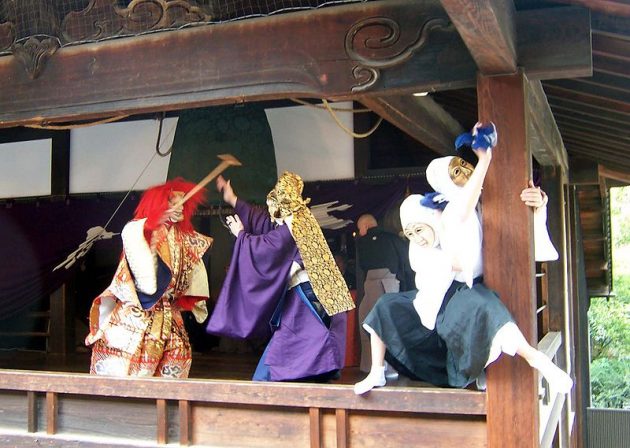
[O]n the first day of spring—which falls at the beginning of February—after throwing beans and playing at devils, we went to Mibu Temple in Kyoto. We stood in line for the better part of a cold hour, then sat down in the outdoor theater to see the eleventh-century pantomine named for this day: Setsubun.
The drum and flute welcome us and a young woman sweeps onto the sock-polished board, played by a man with a great handsome body and a small white mask, her expression carved in the moment of beginning to smile. We know she is a prostitute by her obi, the firm square knot tied in front. With bold, balletic movements, feminine and yet unlike the gestures of any living woman, he hangs the ancient Setsubun talismans of herring head and holly leaf on her doorposts. We know she is kind because an old man comes to her door and she makes a gift of dried beans to him from a great square wooden measure.
Then an oni with a magical hammer comes to tempt her, dressed as a mortal man. He strikes his hammer once, and magnificent kimono appear from thin air, which she accepts with protest and delight. He strikes his hammer twice, and fills her arms with lavish obi. He strikes his hammer a third time, and an enormous kettle of sake appears, and a red lacquered saucer cup the size of a shield. The woman pours first for the man, as custom requires, and he drains the saucer at one go. He pours for her, and she pretends to drink, tossing the sake away. His eyes go heavy with drink, and while he sleeps, she steals the magic hammer. There is something strange about him. She tugs on his cap and gloves and discovers, as he wakes, that he is an oni! Enraged, he makes to attack her, and she seizes the nearest thing to hand: her measure of dried beans. It is stunning, the swiftness of her movement across the stage, the vigor of her arms as she pelts him with handful after handful of flung beans, the way the oni crumples from ferocious demon to craven beast. The crowd howls with delight at the girl’s triumph—and at the sudden break from the stately tempo—and at the white beans whizzing across the stage—and that the play is over; we can go drink something hot at last.
Setsubun is billed as a Buddhist morality play, and yet what is the moral? That a plucky and discerning girl can beat a demon AND keep the kimono, the obi, the magic hammer? Japanese literature is not known for its happy endings, and yet here is the Setsubun girl, emerging once a year for nine hundred years, as ordinary as a miracle for the return of spring.

Header photo by Chris Gladis (Wikimedia Commons)